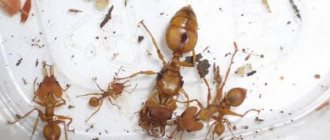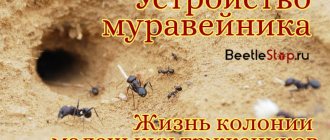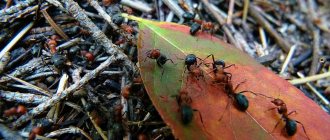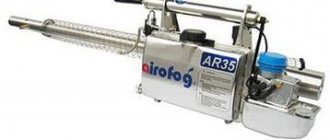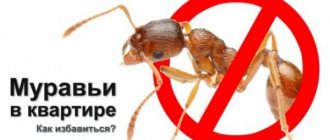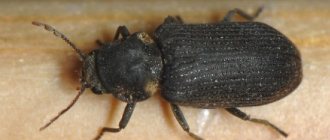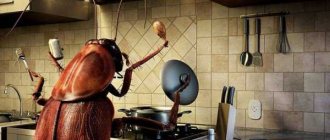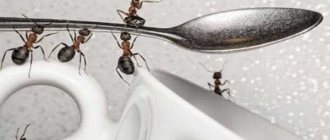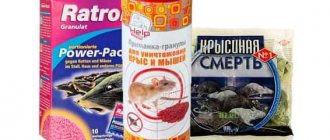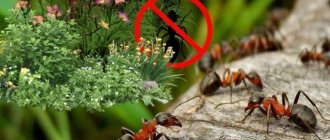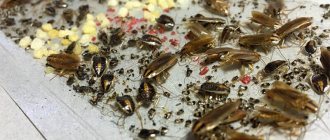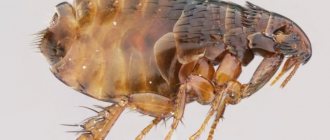The genus Camponotus (carpenter ants) is the largest of the genera that make up the subfamily Formycin. Camponotus has 1000 species of ants, whose life is in one way or another connected with wood. The carpenter ant got its name from the fact that its habitat is trees, in which it makes passages under the anthill. Some woodborers eat wood. In this they are helped by special bacteria that help digest roughage. Another part of this genus uses trees only as a habitat. These woodborers are omnivores, but do not feed on wood, they only make passages in it.
Interesting!
There are 16 species of carpenter ants living in Russia. Three of them are omnivores, love to live in wooden houses and can cause serious problems for home owners. They differ from other species of ants not only in size, but also in their large head with powerful triangular mandibles.
Introduction
Carpenter ants are a genus of ants that build their colonies in wood. These insects are common on all human-inhabited continents and cause harm to households and gardens. In order to answer the question, how to get rid of carpenter ants , it is worth getting to know them a little better.
Carpenter ants are usually black and quite large (up to 1.2 cm). Their appearance in the spring next to a timber structure or tree usually indicates that their colony is somewhere nearby. Unlike termites, carpenter ants do not feed on wood in the house, but make their own colony in it. The crushed wood is removed from the galleries and passages to the outside.
What inconveniences do they cause?
Damage from ants
The appearance of black ants at the dacha causes a lot of trouble. After all, these insects bite very painfully. When the skin is punctured, they release a special substance that causes itching and burning.
Lasius niger ants also have a negative impact with their vital activity in the following cases:
- Eating crops. Large black ants in the garden readily feed on strawberries, wild strawberries, potatoes and many other crops. A huge colony can destroy a large amount of crops over the entire summer period.
- Increased soil acidity. The garden ant leaves its waste products on the beds, as a result changing the composition of the soil. This fact negatively affects plant growth.
- Deterioration of crop growth. You can often find a nest of ants right in the roots of garden plants. This seriously weakens cultures and inhibits their development.
- Spread of pathogenic bacteria. Garden black ants have direct access to human food, because they can easily get into the house. Insects carry bacteria that can lead to infection with typhoid, diphtheria, salmonellosis and other dangerous diseases.
Black ants pose the greatest danger to small children and pets. Trying to protect their own queen, they can seriously bite the victim and cause discomfort.
Damage from carpenter ant
Carpenter ants can cause irreparable damage to wooden structures and objects in the home. For wooden suburban buildings, this problem is especially relevant, since over several years of ignoring the problem of an unpleasant neighborhood can develop into an emergency situation and require major repairs or a complete reconstruction of the house. The first signal for you should be the appearance of small holes on wooden surfaces, as well as sharp creaking sounds that come from them.
Traditional methods of insect control
If it is impossible to use the method of killing ants, which is based on chemicals, you can resort to traditional methods. Most of them will only save you from working ants, significantly reducing their numbers. Without removing the main source of their reproduction, you can fight pests for years. Therefore, the methods described below are only suitable if the number of parasites in the house is not large.
How to get rid of carpenter ants using traditional methods? The most popular ones are described below.
- If it is possible to access the nest of parasites, a good option would be to simply pour acetic acid or boiling water over it. This will result in the death of the queen and most of the ants.
- Special traps are created using a syrup consisting of honey, sugar and water. Worker ants, crawling for sweets, drown in them.
- In places where there are large concentrations of insects, sticky tape is laid out, which is flavored with a sweet product.
- Yeast is mixed with water and honey or sugar, and then placed on the ants' paths, as well as near the nest. Individuals who try this bait die and can be easily disposed of in this way.
- Coffee grounds attract pests. It is left near the anthill in several places at once.
- The main condition is that after placing baits or traps of this kind, it is important to prevent parasites from accessing the water.
- There are other ways to combat these pests that will get rid of them forever.
Chemicals
Don’t trust folk remedies, but how to fight carpenter ants ? Then choose special chemicals. Most of them kill the ant not during infection, but a little later, when it manages to take the deadly poison home and infect its fellow tribesmen. They are quite cheap and are always available at the nearest hardware store.
Fumigation with phosphine
Fumigation is the introduction of gaseous and vaporous substances into the habitat of pests. The phosphine-based fumigant comes in the form of a gas and therefore penetrates into almost any crevice. Thanks to these features, fumigation leads to 100% destruction and purification of harmful insects. This is why phosphine fumigation is so often used to control carpenter ants.
Microwave method
Another popular method of controlling carpenter ants is the microwave method. Under the influence of the microwave field, all harmful insects are easily destroyed. And this is in the absence of any harmful reaction to the wood. A distinctive feature of the microwave method is that it works directly and only on the space required for processing. When working with such an installation, the ambient temperature does not increase. Equipment that creates a microwave field generates vibrations of water molecules, both in ants and in wood. And with this help, the wood is heated to the required 60°C, the temperature required for the complete death of woodworms.
Professional methods
Cold or hot fog treatments used by professional exterminators are the best examples of how to remove pests while minimizing harm, effort and time. Penetrating into any cracks and microcracks, the fog even affects places that are inaccessible by self-processing. The products used in this case, based on innovative mixtures, not only make it possible to get rid of pests for many years, but are also completely safe for humans and do not leave traces on the objects being treated. Just one call and the ants will stop terrorizing you. At the same time, all that is needed directly from the owners of the house is to simply leave the home for a couple of hours.
Popular folk remedies
Methods are the most common among the population facing the described problem. Not only do they consist of components that can be found in every home, but they are also easy to make and use.
Wonderful aroma
Ants have high olfactory abilities. Thanks to this, they find food over long distances, and this is what people use to fight them.
Note! The list of aromas that are unpleasant to insects includes the smells of plants such as chamomile, mint, tansy, garlic, lavender, geranium and elderberry. They can't stand cinnamon and ginger.
As well as essential oils of lemon, lemon balm, orange and anise.
These traps can be placed in a variety of ways. Some moisten napkins and place them in corners and shelves in the house, others prefer scented candles, and still others simply place sprigs of plants in the apartment. In any case, this is a reliable and effective method.
Yeast treat
According to reviews, the method actually helps to get rid of ants and return to comfortable living conditions. To expel creeping creatures, you need to prepare special balls. Yeast is mixed with sugar filling and placed in places known to insects. When they see such a delicacy, they want to treat their relatives and roll the balls into their holes. After this, they are unlikely to want to live in this house and will go in search of a new refuge.
Nuclear mixture
Arthropods have a bad attitude towards mustard and hot pepper. The recipe involves mixing the ingredients. For better effect, ground coffee is added to the composition. The resulting mass should be scattered on the floor in a private house and the cracks should be filled with it especially generously. This powder infects the respiratory tract of insects and impairs their ability to move.
Boric acid
Boric acid
5 g of the product in dry form should be added to a glass of hot water. Then sprinkle 2 tablespoons of sugar and dilute with cold water to get half a liter of solution. Saucers with acid are placed near the ant paths.
Features of the red-breasted carpenter ant
This pest is famous for its large size. The length of the soldier varies from 1.5 to 1.8 cm.
The body of the parasite is divided into segments. The insect's abdomen is oval, matte, with red spots at the base.
The breast is quite thin and has a cubic shape. The head is “equipped” with powerful jaws, mustaches and a pair of “antennas”.
Females have wings, which they get rid of after mating. Males rarely have wings. A larger percentage of these insects are workers.
Nutrition
Carpenter ants eat several times a day.
Their menu consists of plant seeds, mushrooms, and tree leaves. Once inside the house, the ant feeds on dairy products, gelatin and eggs.
Reproduction and life cycle
Not all insects participate in reproduction. The overwhelming percentage of this large family is made up of females who keep order and do construction.
Only a few young males and females reproduce.
Mating occurs once, after the insects have wings. This is observed in the summer.
After fertilization, the males die, and the females lay eggs in a new place. Ant eggs have a white tint. The larvae are yellow and their size is 0.5 cm.
Preventing the appearance of black ants
To avoid wasting time and money fighting uninvited guests, be vigilant and do not give them the opportunity to get into your house or land, including after successful liquidation.
It is important to clean the apartment regularly, wipe the floors in rooms and premises with a damp cloth; leave work surfaces, the stove, the kitchen floor clean: plates, cups, pots that sit for a long time with leftover food attract ants, as do towels that smell of food, greasy window sills or blinds; seal pipe joints and their entrances into walls, ceilings and floors in the kitchen and bathroom; putty the walls on the balconies; Protect window and door openings with nets, and hang citrus-scented insect repellent sections near windows, doors and ventilation ducts; eliminate branches of a fruit tree or old bush near windows, remove fallen leaves and branches; leave garbage away from the site in a specially organized place, and cover the household waste bin with a lid; periodically check the functionality of the sewer system; Eliminate cracks in floors and baseboards in a timely manner.
How to protect your garden from black ants
Prevention is also possible on a personal plot:
- eliminate weeds and dry plants in a timely manner;
- monitor the formation of aphids and destroy them in a timely manner;
- do not allow pieces of food to get into the area;
- Every year in the spring, spray the soil with special insect repellents, treat with boiling water, dig, loosen;
- destroy likely places for insects to hide - stumps, snags, old boards;
- whitewash the trunks of garden trees with lime, secure them with adhesive tape or foil: the ants will not get to the sweet fruits.
Description, reproduction
There are several species of carpenter ants. The most common of them are black, they live in deciduous forests and build anthills in rotten stumps or in tree hollows, and gnaw their nests in damp wood. This is their main food.
The second species differs in color and length: red-breasted, shiny, large (from 12 to 15 millimeters), females with wings.
Ask and receive useful advice from professional gardeners and experienced summer residents.>>
Among such ants there are larger individuals. These are soldiers, they reach 18 mm in length. These insects love to settle in wooden houses; they choose places for their nests indoors, in rooms, and gnaw passages in wooden walls and parts. Ants reproduce endlessly; the queen is capable of reproducing offspring until the end of her life, up to 15 years.
Organization of life
Ant Reproduction
The fire ant has a standard life support system. Families consist of three clans:
- Uterus.
- Working individuals.
- Brood.
Unlike other brothers, in the fire family there can be several individuals responsible for laying eggs. This allows them to reproduce at an impressive speed. Working individuals are females who are not capable of reproducing offspring.
The brood group includes all life stages up to the sexually mature individual: eggs, larvae and pupae. Their development is completely dependent on adults. The individuals responsible for the population hide the future cubs as deep as possible in the anthill and carefully monitor their diet.
Fire ants try to arrange their home as close as possible to the food source. This could be agricultural land or human habitation. That is why in countries where representatives of the fiery species are found, active work with the population is carried out. They regularly broadcast photos of the red ant, warning about the danger of its bite and how to detect it. It is also mandatory to carry out chemical treatment of agricultural objects, veterinary control of livestock and first aid training for bites.
Signs of ants in the house
Ants are easy to spot. They do not walk alone, but prefer to move in groups or along a path, following the same route. Carpenter beetles leave dust next to their nests, which is obtained from wood ground by their mandibles.
How to find a nest?
It is useless to breed insects one individual at a time; you need to find a place where the entire population lives. You can try to find the nest by searching the house and rooms, but it is better to use a trick. Any ant will drag food into its anthill, so when you find a path or dust, you should put bait there (they love sweets) and watch where the insect runs with it.
If the nest is in furniture, then such an object can be sprayed with special means; it is easier to take an anthill in a wooden box out into the street entirely, but it is difficult to eradicate settlements that are invisible to the eye. Then poison comes to the rescue: drugs that destroy both egg laying and adult individuals.
What to poison with?
Humane measures against woodworms do not work. These insects cause irreparable damage to individual wooden objects and are capable of chewing not only the veranda, but also ruining the house. Therefore, we have to act radically: fight with the help of chemicals. If animals and children live in the house where the ants have settled, it is recommended to try gentle methods.
Traditional methods of killing ants
Where children and animals live, it is recommended to use organic products first. Systematic treatment of a wooden house with them allows you to get rid of the few insects that are just looking for a place for a new nest and have not had time to gnaw holes in the wood.
The carpenter ant does not like boric acid. It is mixed with sugar or honey, laid out on saucers and placed next to the anthill.
These pests are controlled using vinegar, yeast, garlic and black soap. Garlic scares away ants, and they leave houses where this plant lies.
To combat carpenter ants, you can use carboxylic acid (2 tablespoons), which is mixed with black and laundry soap and diluted with water. Fill the anthill with this solution three times in one day and do this for two days in a row.
You can also pour a solution made from yeast and granulated sugar into the nest. You can prepare the following traps: cover the bottom of a bowl with honey or sugar syrup and place it near the insect population. Woodworms crawl to feed, climb up to the treat and get stuck in it. If the nest is located on the site, it can be burned by pouring gasoline on it. But doing this near your home is prohibited.
To repel carpenter ants, you can also use ammonia, as for their garden counterparts:
If traditional methods do not help, you will have to use the following means: ·
- Expel;
- Mrowkofon;
- Drione Pest Insecticide Dust;
- Pyrethrum;
- Diatomaceous earth;
- Delta Dust.
When the nests are visible, they can be treated with powders or gel. The gel is applied along ant paths, and insects drag it into houses, and the powder infects the queen and the entire population.
Behavior
The garden black ant is a non-aggressive creature, but endowed with a sting with poison. They use their weapons during hunting, when enemies attack, or when danger approaches. The insects bite quite hard, leaving an inflamed red mark. For a person prone to allergies, an ant bite can cause serious health problems.
Interesting!
There are always several adults guarding order. In case of danger, they give a signal to the others and attack the enemy en masse. In an instant, a whole colony of insects appears on the foot of a person who steps next to an anthill.
An insect will not just bite. He will crawl freely along his arm and leg if he is not in danger. The slightest pressure on the body leads to a defensive reaction.
On a note!
In nature, there are a huge number of giant black ants that can bite domestic animals to death and cause significant damage to human health. This type of ant lives in tropical countries. When insects infest, residents leave the house, taking their entire household with them.
Chemicals
When a nest is discovered, it is recommended to set traps or bait mixed with something sweet at its supposed entrance. An ant that liked the treat will bring it to its fellows and infect the entire population in the anthill. Within three days after infection, all insects die.
Gel preparations:
For each nest you need to make three baits by mixing any of the preparations with jam or sugar. The poison contained in the gels will destroy all insects, they will disappear forever.
Sprayers:
The aerosol only affects those carpenter ants that are visible. It is difficult to cause great harm to the entire population. However, if a nest is found within reach, you should use the following means:
Treatment should be carried out in a room without animals and children, since this drug is odorous. A description of the use of the sprayer can be found in the photograph on the can: “Point the stream into the nest when all the insects are in it (after five o’clock in the evening).” Spraying this product is done at least 3-4 times.
It is worth remembering that you cannot apply the drug to the ant paths themselves. This repels insects; over time, they will learn to bypass the poisonous place, and fighting them will not lead to the desired result.
Ants are useful when working in the forest, but in human habitation they are nothing but trouble and anxiety.
Remedies for carpenter ants: review of 10 products
The package for ~$3.34 contains four stations with baits. They are used indoors. The product works for three months and is replaced with a new one if necessary. The manufacturer guarantees a money back if the product turns out to be ineffective. There are quite a few negative reviews on Amazon.
A 30 ml tube of gel turned out to be one of the most popular products. It costs ~$26.64 and has a shelf life of two years. The gel is designed to combat many types of ants in the house. Amazon users gave it over 80% of the highest ratings. To use, a small amount of bait is squeezed into a crack or other hard-to-reach place near the anthill.
The product is sold in a pack of six stations with baits for ~$6.08. The station is installed in the ground or on the surface. The principle of operation is the same: transfer the poison to the worker ant so that it does the same in the anthill. Buyers praise the bait. It can be purchased in strips and in small stations of eight for ~$6.17.
The insecticide contains bifenthrin and sells for ~$14.05 in a 5-liter canister. It is sprayed onto a dry surface, after which it is not removed for 24 hours. The product is lethal to insects and creates a barrier that protects the area in the house for up to a year, and outside for up to three months.
A bottle of spray costs ~$8.97, but a concentrate is also sold. The spray kills many types of insects, including ants. As buyers write on Amazon, the product does not affect all types of ants, but woodworms are not mentioned among them. Can only be used outdoors.
A professional insecticide containing 4.75% deltamethrin costs ~$41.42. The product is diluted in a large amount of water, and it is enough to spray it over a large area indoors or outdoors. The spray leaves no odor and is rated positively on Amazon.
Talstar spray contains bifenthrin and is suitable for fighting ants. Sold in concentrated form for ~$41.65. It is mixed with water and sprayed. Validity period is up to three months, provided that it is used correctly on a dry surface.
Attention: the insecticide is toxic to aquatic animals and plants and should not be used near bodies of water. Avoid contact with skin (use gloves) and mucous membranes. Wait for the treated surfaces to dry, then they will become safe.
Diatomaceous earth is a universal non-toxic remedy for insects and arachnids. The remaining diatoms are crushed to a specific size where they become sharp weapons against insects. The edges of diatomaceous earth particles cut the chitinous cover of the insect and damage it. The product will help get rid of the carpenter ant. It is safe for people and animals and cannot harm the skin. Sold in a 1.8 kg bag. Cost ~$14.47. Sprinkle this flour on the places where ants accumulate and migrate into the house.
Another traditional remedy is boric acid. A 450 gram tube sells for ~$6.99. Acid was previously used as an antiseptic, after which it was replaced by stronger antiseptics. Boric acid is also used in the fight against ants. The powder is placed in the cracks, behind the baseboards, and sprayed through the entrances to the anthill.
Clove oil is not an insecticide, but is also used to repel insects. To do this, it is diluted with a large amount of water. Warning: essential oils are dangerous for pets, especially cats, pregnant women and small children. Should not be used in its pure form.
Red-breasted carpenter ant
The carpenter ant is considered one of the unwanted and uninvited guests in a person’s home. He, along with his red brownie “namesake,” causes a lot of trouble. The main one is that they carry dysentery, polio, typhoid fever, and plague. They infect the area with worm eggs.
Red-breasted carpenter ant - photo in the natural environment
Selected species
C. pennsylvanicus
, winged man
C. crispulus
queen
Damage to wood from C. herculeanus
This structural board was destroyed by carpenter ants. They emerged from the dense "latewood" with each growth ring intact to be used as a gallery.
This structural board was destroyed by carpenter ants. They emerged from the dense "latewood" with each growth ring intact to be used as a gallery.
- Camponotus aeneopilosus
Mayr, 1862 – golden-tailed sugar ant - Camponotus amaurus
(Espadaler, 1997) - Camponotus athensapis
- Camponotus anderseni
- Camponotus atriceps
- Florida carpenter ant (cf.
C. floridanus
) - Camponotus Bishamon
- Camponotus chromaiodes
- red carpenter ant - Camponotus cinctellus
– shiny sugar ant - Camponotus compressus
(Fabritius, 1787) - Camponotus consobrinus
– ribbon sugar ant - Camponotus sgazzis
Mayr, 1862 - Camponotus cruentatus
(Latreille, 1802) - Camponotus daitoensis
- Camponotus detritus
Emery, 1886 – Namib dune ant - Camponotus Empedocles
- glossy sugar ant - Camponotus ferrugineus
- red carpenter ant - Camponotus festinatus
(Buckley, 1866) - Camponotus flavomarginatus
Mayr, 1862 - Camponotus floridanus
, Florida carpenter ant, genome 90% sequenced - Camponotus gigabyte
(Latreille, 1802) – giant wood ant - Camponotus haroi
(Espadaler, 1997) - Red-breasted carpenter ant
(Linnaeus, ) - Hercules ant - Camponotus arotsis
Mayr, 1866 - Japanese carpenter ant - Camponotus Kaura
- Camponotus ligniperda
, a common species in Europe - Camponotus Modoc
Wheeler, W.M., 1910 - western carpenter ant - Camponotus Monju
- Camponotus nearcticus
(Emery) – smaller carpenter ant - Camponotus nigriceps
(Smith, 1858) – lake sugar ant - Camponotus novaeboracensis
- Camponotus pennsylvanicus
(Degeer) - black carpenter ant - Camponotus reburrus
Mackay, in Mackay & Barriga, 2012 - Camponotus punctulatus
(Mayr) - Takuru ant - Camponotus saundersi
- Camponotus schmitzi
Stärke, 1933 – diving ant - Camponotus sericeus
- Camponotus silvestrii
Emery, 1906 - Camponotus Taino
- Camponotus tortuganus
(Emery) – Tortugas carpenter ant - Camponotus triodiae
- Camponotus universitatis
Trout, 1890 - Camponotus wandering
Scopoli, 1763 - Camponotus variegatus
(Smith, F., 1858) - Hawaiian carpenter ant
Why are insects difficult to control?
The vitality of ants and the persistent tendency to replenish the population is explained by the following:
- Omnivorous: they eat any food, but especially give preference to leftover food rich in carbohydrates and animal proteins.
- Small in size, allowing you to hide in secluded, inaccessible and damp places. Moving into our homes, the carpenter ant and its team inhabit bathrooms, kitchens, bathrooms, etc.
- The ability to maintain viability without food and water for five days.
Consolidate the result
Smells that repel ants After carrying out active measures, a reliable rear should be provided so that a new colony of ants cannot settle after a while.
It is necessary to seal all the cracks in the wall, the gaps between logs, in window sills, under baseboards. Do everything to prevent small insects from entering the house.
Since it is difficult to ensure complete isolation of the room, repellent substances should be used. It is better to expel uninvited guests using folk remedies.
- Place chopped garlic or whole cloves around the perimeter of the house, on window sills, behind furniture. Rub the arrows of winter garlic on the walls.
- Scatter cinnamon indoors. Suitable ground or in sticks. In the latter case, the smell lasts longer.
- Plants are laid out in the house - chamomile, peppermint, bouquets of wormwood, tansy, elderberry. In the absence of plants, you can use essential oils. They drop it into the water, rub it on the floor, walls, and leave it on a plate.
- Carry out general cleaning of the house using a vinegar solution. Ammonia has a similar effect.
If ants appear in a wooden house, it is necessary to identify the anthill, carry out disinfestation, and provide prevention
Since insects enter the house from the outside, attention should be paid to the garden area. Plant mint and calendula around the perimeter of the house, create beds with garlic
Red-breasted ant at home: characteristics of a household pest
Ants are considered the largest intellectually developed family among insects. The red-breasted carpenter ant is considered one of the largest representatives in this family: soldiers grow up to 15-18 mm in length. Characteristic matte belly with a slightly noticeable reddish tint at the base. It got its name due to the fact that it builds nest-dwellings in the wooden parts of the house. Therefore, insects can be found both under the veranda and inside rooms throughout the premises.
Attention! It should not be confused with the carpenter ant, which has a black, slightly matte body. It lives mainly in pine, deciduous, mixed forests, and in clearings, making its nests in dry stumps and woody remains.
The black relative is a carpenter ant that does not live in human dwellings
Varieties
Lasius niger
This is the most numerous species. Distributed in Europe and central Russia. Found in Siberia and Mongolia. The color of adults is black or dark brown.
Nests are often located in the ground. They can be seen by their characteristic mound. Less commonly, a colony of black ants settles in tree bark or under stones. Young females establish colonies on their own, without the help of worker ants.
A characteristic feature of the species is the long life of the queens. According to some reports, they live up to 2 years. The queen is always alone in the colony. Reproduction occurs from early summer to late August.
This type of ant feeds on the sweetish secretions of aphids. To provide themselves with food, adult insects diligently protect pests from attack by other families of ants. And if necessary, they even transfer aphids to whole leaves of plants so that they can reproduce successfully.
For the winter, be sure to take several aphids into the nest . And the next year, with their help, a new “farm” is bred.
Lasius flavus
Distributed throughout Eurasia. Found in Japan, North Africa and North America.
The color of adult yellow ants is light brown with a yellowish tint. The body is devoid of small hairs and appears translucent.
The size of females is up to 7 millimeters, sometimes more. Nests are placed in the soil, with mounds placed above them. Most often, large colonies are found in flat areas and in gardens overgrown with thick grass. They practically do not reach the soil surface. They lead a secretive, underground lifestyle.
They feed on secretions of root aphids, which are bred as needed.
Lasius alienus
Lives in Europe. Also found in the Caucasus. The body color of pale-legged ants is light brown. The head has large eyes - this is a characteristic feature of the species.
They prefer to settle on lawns, digging out small craters in them. They also nest under sidewalks or large rocks. They lead a secretive lifestyle.
They feed mainly on dead insects. Less commonly, aphids parasitizing flower beds. They actively reproduce in the summer, damaging lawns.
Signs that you have carpenter ants in your home
- In appearance, it is a black or dark brown representative of the family, having a segmented body and three pairs of legs. On the head there are slightly bent “antennas”, antennae, and 4 or 5 toothed mandibles. The female has wings that shed after the mating season. Males are slightly smaller (9-12 mm), also winged.
- “Hard workers” individuals lack wings. You can recognize such insects by their characteristic path along which they move one after another without losing their route.
- The “trace”, characteristic specifically of carpenter ants, is dust reminiscent of fine sawdust ground into flour. This is the result of the work of insects building a nest for themselves in a wooden box, threshold, wall, beam, support, etc. In general, wherever there is damp wood.
- When a clutch is discovered, round white eggs can be seen. They are difficult, but can be distinguished with the naked eye. The larvae are up to 0.5 mm long and yellowish in color. There may also be pupae there.
Care requirements
- Feeding – All woodworms require regular feeding of syrup, and almost all require feeding of fresh insects.
- Formicarium - most woodworm species start in the soil, and only as the colony grows does it settle in the tree. Therefore, as the first formicarium, it is worth using formicariums with moisture (there are exceptions).
- Humidity gradient – cocoon maturation does not require high humidity, so local humidification will be beneficial.
- Lighting – A heating lamp combined with a shelter in the arena creates a nice solarium for the ants to warm their cocoons.
- Wintering - all woodworms in the middle zone are recommended to winter - otherwise the colony may die. Read more about wintering in our article - “Wintering with ants”
How to find a nest?
To actively fight insects, you need to destroy the nest, then the entire population will leave the house in search of a better place. To do this, you need to be patient and watch where the workers take their food. Near the pile of dust you should place bait (sweetness, a drop of jam, etc.). Having taken it “for testing”, the ant will drag the treat to the nest. The path will lead you to a wall, closet, door frame, etc. If the anthill is within reach, it can be treated with various means. If it is hidden or inaccessible, the only way to influence insects is to spread poisonous bait.
The female sheds her wings
Attention! It will only be beneficial if the poisonous substance does not act immediately. Its effect will appear gradually. Otherwise, the worker ant will die before it carries the poison into the nest and feeds the female and other insects. When the toxic helium mixture enters the intestinal system of ants, it acts gradually, which will allow the population to be completely eliminated within three days.
Fight with sprayers
The nest, which is easy to get to, can be destroyed using sprays. A special powder is placed in them - a remedy for carpenter ants. Stores that specialize in means of protection against various pests have a wide selection of such drugs. You can use ready-made sprays: “Dichlorvos”, “Regenta”, “Raptor”. Direct the stream towards the nest. The treatment is carried out several times. It is better to do this in the evening, when all the ants have returned home.
Do not spray paths along which insects move. The drug will scare away the worker ants, who will soon build another path for themselves, and the queen will remain and continue to reproduce.
Remember: such products are highly toxic. Therefore, when using them to combat carpenter ants in the house, you must follow the instructions for using the drug. Do not spray sprays in areas where children or pets can reach.
Chemicals must be used in a respirator and protective suit. Hands are protected with gloves.
What to poison with?
Before deciding on a toxic substance, it is necessary to assess the degree of harm already caused. It happens that a tree is completely pitted with ant passages. If it is possible to replace damaged cladding elements with new ones, it is better to do so.
Chemicals
When nests are located in the public domain, they must be immediately treated with powder or helium compounds. The powder destroys, first of all, the female queen, and then the entire population in the nest. Apply the gel in a strip along the ant paths. The following drugs work effectively:
- Drione Pest Insectic >
Traditional methods
- Although chemicals in the form of aerosols are considered ineffective, the folk method of spraying places where “tenants” gather with the following composition: completely dissolve 150 g of iodized salt in one liter of water, it is quite effective. Spray the nest itself and the areas of greatest concentration of ants with this mixture twice a day. The paths themselves cannot be touched: insects that have gone astray will begin to look for another place for a nest.
- Don’t forget the time-tested boric acid. It is available for free sale in pharmacies, online, and garden stores. The chemical is mixed in a 3:1 ratio with powdered sugar. The resulting mixture is distributed in boxes, bags, and plastic bottle caps around the room in places where ants are most concentrated. A curious insect, having stained its paws in the sweet bait or brought it on its body, infects itself and its neighbors in the nest. Once inside the ant’s body, the acid begins its destructive action, like rust, eating its insides.
- Electronic ultrasonic repellers are also popular. The sound created by the device is beyond the sensitivity threshold of the human ear, but insects leave the area under its influence.
- Don't neglect Chinese crayons either.
Boric acid and powdered sugar are a killer remedy against the red-breasted ant
Positive and negative sides
The presence of ants on the site also has positive aspects - in the habitats of colonies, the soil is enriched with phosphorus 10 times higher compared to soil without these insects. The potassium content in such areas is increased by 2 times - the element is contained in it in an already dissolved form, which facilitates its absorption by plants.
But even against the backdrop of the listed advantages, the harm from ants is much greater - they are actively breeding another dangerous pest - aphids, and also cause serious damage to the structure of the soil. For flower beds, alpine hills, and lawns, ant colonies are at the same level as moles in terms of danger. The anthill penetrates into the depths of the soil, where it branches widely - the passages are difficult to access by cold, insecticides or other neutralizing agents. The red ant is a serious threat to strawberry and strawberry fruits, vegetables and root vegetables (especially sweet ones), buds and flowers. There is also always the possibility of their migration to people’s homes - any food is used there and it is difficult to get rid of such “neighbors”.
How to protect your home from penetration of carpenter ants?
In order not to have to solve the problem of how to get rid of insects, you need to create conditions unfavorable for their residence.
- Prevent any insects from entering the room from outside: trim branches of fruit trees and shrubs hanging to the window.
- Do not create sources of ant settlement: promptly remove heaps of garbage, fallen leaves, fallen branches, etc.
- Carry out constant wet cleaning, without leaving food waste or spilled liquid on the table.
- Keep the trash can covered.
- Do not leave unwashed dishes in the kitchen.
- Fix plumbing leaks.
- Seal gaps, cracks, adjust the doors so they don’t sag.
- Protect openings (windows, doors, vents, transoms) with nets.
Use natural repellents: turmeric, ground pepper (black, red), essential and lavender oils, talc in baby powder. When it is established that the ants have multiplied, there are quite a lot of them, repelling methods will not help. It is necessary to use preparations based on insecticides. Highly effective chemicals will forever rid your home of annoying “neighbors”.
{SOURCE}
First steps to success
When you see ants, you should not stomp your foot, crush them with your fingers, lay out sticky traps, there is no point in this. Insects that crawl in search of food are worker ants that do not have the ability to lay eggs or continue their race. The main target is the queen, located in the nest, anthill. This is what you should look for.
If there are ants in a wooden house, you need to treat them with sweets and watch where they take them. These are not measures of hospitality, but ways to find out where the nest is.
The ants will move towards the home along the studied route. Having noticed their trajectory, you can explore the area. The main symptoms are the presence of rot and holes in the logs. Ants place nests between beams, in walls, insulation, wooden furniture, doors, and under baseboards.
If you manage to find an anthill, it will be much easier to fight the ants. A destroyed nest serves as the basis for the relocation of all residents to more favorable places.
Red myrmica
Myrmica is a species of small red ants, about four to five centimeters long. The body has a color from yellow to red and brown. This species is most common in Eurasia. Such forest ants are often found in meadows and vegetable gardens, competing with the well-known black ones. An interesting fact is that they have mastered not only wild nature, but also urban landscapes. To protect themselves, small red ants use a sting and poison, which has a rather painful effect on the body, especially when the bites are numerous. Sometimes people have an allergic reaction due to the ingress of acid (formic).
Consolidate the result
It is necessary to seal all the cracks in the wall, the gaps between logs, in window sills, under baseboards. Do everything to prevent small insects from entering the house.
Since it is difficult to ensure complete isolation of the room, repellent substances should be used. It is better to expel uninvited guests using folk remedies.
- Place chopped garlic or whole cloves around the perimeter of the house, on window sills, behind furniture. Rub the arrows of winter garlic on the walls.
- Scatter cinnamon indoors. Suitable ground or in sticks. In the latter case, the smell lasts longer.
- Plants are laid out in the house - chamomile, peppermint, bouquets of wormwood, tansy, elderberry. In the absence of plants, you can use essential oils. They drop it into the water, rub it on the floor, walls, and leave it on a plate.
- Carry out general cleaning of the house using a vinegar solution. Ammonia has a similar effect.
If ants appear in a wooden house, it is necessary to identify the anthill, carry out disinfestation, and provide prevention
Since insects enter the house from the outside, attention should be paid to the garden area. Plant mint and calendula around the perimeter of the house, create beds with garlic
Underground roads of wood borers
The stump in which such forest ants live is surrounded by fresh and old sawdust, which indicates continuous work. At the same time, not a single individual is visible around the dwelling itself. The erroneous impression is created that the insects do not leave the shelter. This is not entirely true. It’s just that the paths they use are not visible from the outside.
Black forest ants make underground passages in the surface soil that look like real tunnels. Where do they lead? It's simple: a network of such passages stretches to the nearest stumps and spruce trees, from where woodworms deliver insects and pollen. Underground roads are an excellent alternative to dangerous land routes. In addition, it is more difficult to reach your destination on the ground, and ants move quickly along corridors. Underground pathways become traps for other insects that enter them. Woodworms will happily take advantage of such prey.
Benefits brought by forest ants
Ants are very useful creatures. They secrete a substance called formic alcohol, which is used in medicine to treat arthritis, rheumatism, hepatitis, tuberculosis, diabetes, and kidney failure. This product also helps with excessive hair loss.
Forest ants have a beneficial effect on soil covers, as they loosen them, thereby enriching them with oxygen. In addition, they are food for a number of forest birds: woodpecker, wood grouse, tit, black grouse. The ants themselves destroy a significant number of pests, thereby helping to preserve forest plantations.
